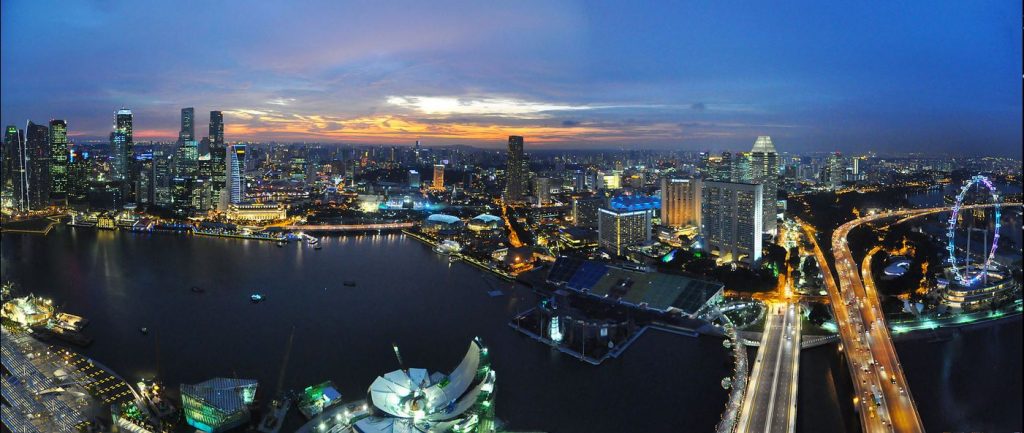
A Tiny State, Vulnerable over Its Water Supply, Turns Weakness into Strength
A four-week dry spell wouldn’t be a crisis in most Southeast Asian countries, but when February became Singapore’s driest month in 150-plus years, the city-state’s six million people were reminded sharply that water scarcity has become a core national security issue. Singapore has been uncomfortably dependent for its water supplies since the 1960s, when, on the eve of independence, it signed two agreements to import its water from the neighboring Malaysian state of Johor.
One of those agreements expired in 2011 and the other will do so in 2061. Singapore worries that Johor may decide to raise water tariffs unilaterally. Under the pressures of drought and those timelines, Singapore has built innovative technologies and policies to gather the rains, refine its wastewater, and desalinate seawater. Through decades of work, it has leveraged its core weakness into a strength, becoming a global leader on water security issues.
Singaporeans have endured repeated water shortages. “We used to have water rationing and as a young kid I had to stand in the line and get water from delivery trucks,” recalled Grace Fu, who is both second minister for the environment and water resources and second minister for foreign affairs, in June at an event on the sidelines of Singapore International Water Week. “Water is precious and not to be taken for granted.”
Droughts in the 1960s and 1970s prompted Singapore to invest millions of dollars in upgrading and diversifying its water sources to be less reliant on Malaysia. One innovation is its Marina Barrage, a 350-meter (nearly quarter-mile) dam across an ocean inlet. It is as strategic for Singapore as are the Hoover Dam or the Aswan Dam for their locales. The initiative, launched by former Prime Minister Lew Kuan Yew, turned Singapore’s Marina Bay into a freshwater lake that serves as a strategic water reservoir and a tidal barrier. The barrage significantly boosted Singapore’s ability to gather and store rainwater, which it now can do from two-thirds of its land area. The dam, largely run on solar power, also is an architectural landmark, museum, and tourist magnet for the city.
In addition to its elaborate rainwater catchments, Singapore refines its wastewater into what the state water utility calls NEWater. Singapore launched the NEWater program in 2001 following the example of Orange County, California, which recycles water to replenish aquifers threatened by encroaching seawater. Singapore blends its recycled wastewater into its potable water supply (and offers it, bottled, to visitors to the Marina Barrage). Today, NEWater fills 30 percent of Singapore’s needs. Building the technologies to purify waste-water at an acceptable cost took more than two decades—and building public acceptance of drinking water refined from waste also was a struggle, officials have conceded. The government hopes to increase NEWater to provide 50 percent of its water supply in coming decades.
Singapore’s remaining source, desalinization, remains expensive. Following the opening last year of a second plant to purify seawater, desalinization now can supply a quarter of the country’s needs.
Singapore’s continued dependence on its cross-border supply from Malaysia is far from unique. As the former Soviet leader, Mikhail Gorbachev, recently noted, “roughly 60 percent of all fresh water runs within cross-border basins”—276 of them. “Only an estimated 40 percent of those, however, are governed” by international sharing agreements. Still, few countries are so reliant as Singapore on a single supplier country.
Singapore’s framing of water management as a national security issue has become an important aspect of the nation’s soft power—and a draw for investors. Since 2008, it has held an annual Singapore International Water Week that it touts as “the global platform to share and co-create innovative water solutions.” The June 2014 edition attracted 20,000 visitors from 118 countries. The mix of government leaders and representatives from more than 800 companies produced agreements on $11.5 billion dollars’ worth of projects awarded or tendered. For Singapore, the nation’s water and environment industry continues to grow and is expected to add $1.33 billion in economic output to Singapore and employ 11,000 people by 2015.
“If you start an important policy conversation, like we did, you must be prepared to offer some solutions,” said Chan Kum, a senior adviser at the Public Utility Board, Singapore’s governmental water authority.
Joseph Hammond is a journalist and a member of the Emerging Leaders in Energy and Environmental Policy Network (ELEEP), a project of the Atlantic Council and the Ecologic Institute.
Image: Singapore's downtown rises above Marina Bay, which the city-state has converted from a tidal, ocean inlet into a freshwater reservoir. (Wikipedia/CC License)
